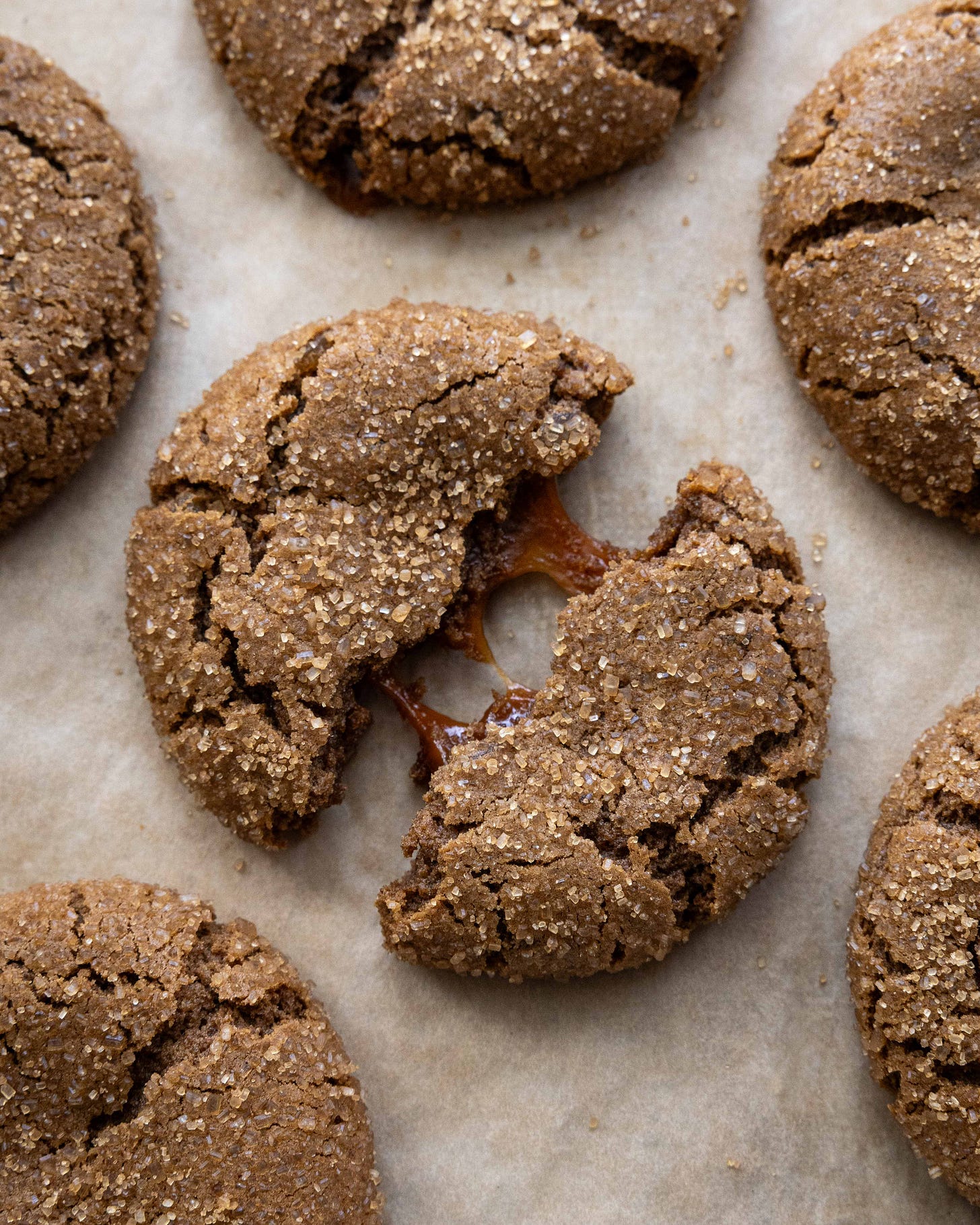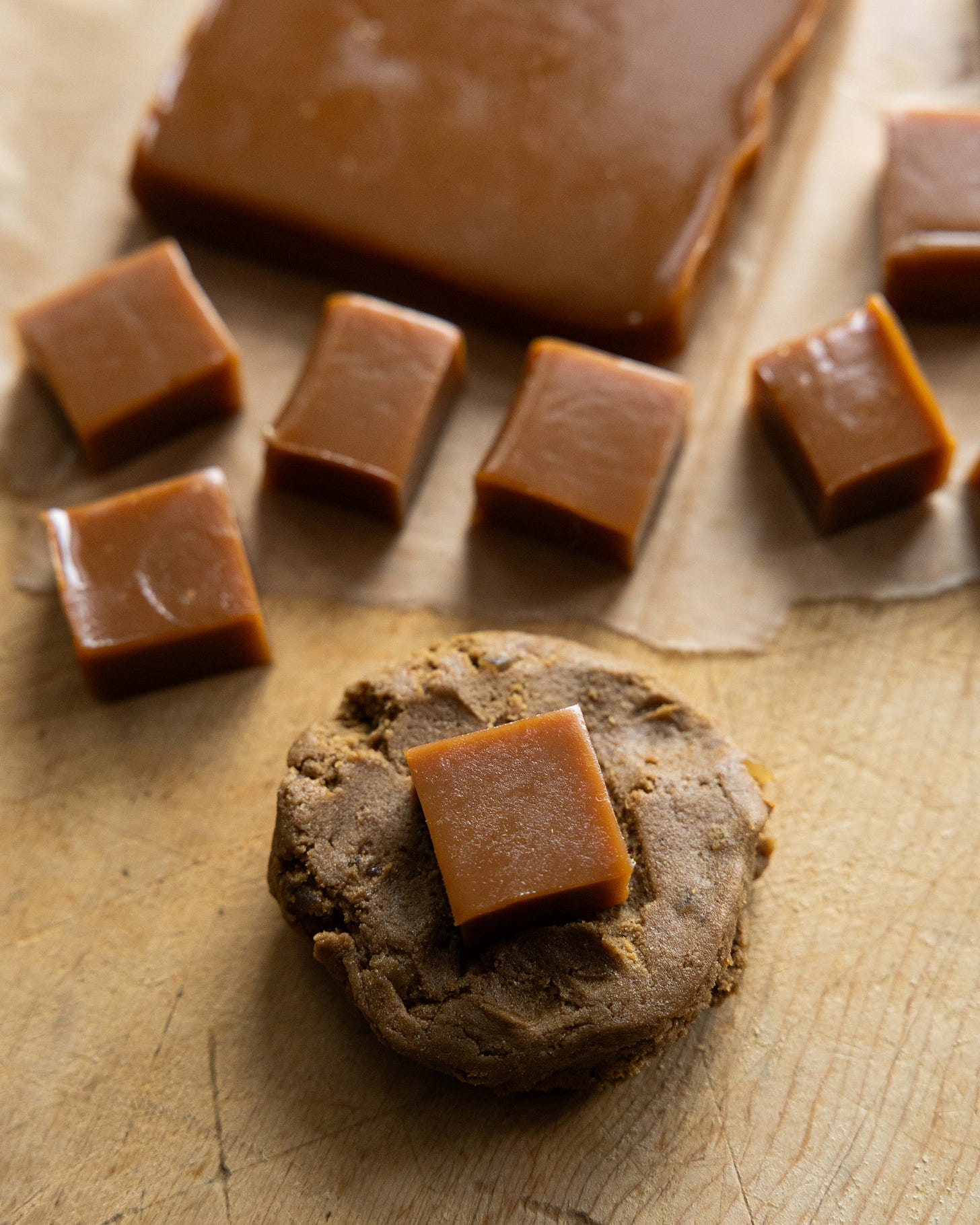Does Caramel Make Everything Better?
Salted Caramel Molasses Gingerbread Cookie
Happy Friday!
Let’s talk cookies. There is a whole wide world full of cookies to explore and I hazard you could easily make a different cookie each and every day and you’d still be able to make something unique each time. Now, we all have our favourites, but choosing a numero uno, the one that takes the biscuit is probably a tricky decision. What about a top 5 ranking? For me thats still a very tough choice but, without a doubt, I would absolutely include Chocolate Chip and Oatmeal Raisin, classics full of nostalgia and, when made well, incredibly hard to beat. The other three slots would be up for debate but, I think, a classic molasses gingerbread cookie would likely end up in the top 5 and when you add caramel to that cookie, as in todays recipe, there is no doubt. These are definitely top 5 material.
When it comes to gingerbread cookies, do you prefer them soft and cakey, dense and chewy or maybe crisp? For me I like to sit slightly on the fence, I want a cookie that has a bit of everything, slightly crisp edge, lots of chewy texture and a centre that remains soft and tender. To achieve this I like to use a mix of plain and bread flours, which help to create a cookie that can achieve all of those textures. The key, then, becomes the baking. Over bake the cookie and you lose the holy trinity of texture, underbake them and you get a cookie that risks a raw or undercooked centre. The second question when it comes to a spice cookie, is what blend of spices are you going to use. For a gingerbread cookie I think you need at least the classic combo of ginger and cinnamon, with a hint of nutmeg as the cookies backbone. Beyond that trio, you can take the cookie in a whole variety of directions. If I was making the cookie, sans caramel, I would dive deep into the spicing, adding cardamom for a hint of floral, black pepper for bite, maybe some clove to add a wintery festive note, you could even add a hint of chilli powder to add heat if that is your sort of thing. For this particular gingergerbread, I wanted to keep things relatively simple so added just the classic combo I mentioned earlier. I did, however, double down on ginger adding a couple balls of stem ginger to the cookie dough, dicing it finely so that every bite had a little chunk of the chewy ginger. In a version I am working on, for a project I’ll tell you about next year, I tripled down on the ginger using a mixture of freshly grated ginger, crystallised ginger and of course ground ginger. The aim of that cookie was to make a cookie that was the ultimate ginger cookie but here, today, I wanted to create a cookie that worked well with the caramel so the spicing, whilst still strong, is a little simpler to allow for balance, to allow the caramel to also shine.
Talking of caramel let’s talk about what I used here. I made a caramel from scratch and before you close this newsletter for good, let me hold your hand a little and promise you that, if you've always hated candy making before, this is very straightforward and well worth making from scratch. If you really really don’t want to make them yourself I do have an alternative. Werthers Originals, the makers of your grandads favourite toffee, also make a soft caramel that would work well here. The flavour is not in the same league as anything homemade but the texture works well and are a good substitute if making them scratch is not for you.
To make the caramel you only need a few things.
A Stainless Steel Saucepan
An Instant Read Thermometer
Loaf Pan
Butter, Sugar, Cream, Salt
Quite obviously you need a saucepan to make caramel, but the most important element is that the pan is not non-stick and is preferably a standard stainless steel saucepan. Why? Simply the colour. When cooking caramel one of the main ways to determine its final flavour is the colour the caramel is cooked to. If you use a dark non-stick pan it can be much harder to judge the colour of the caramel and the likelyhood is that you’ll make a paler caramel which will end up tasting much sweeter without the same depth of flavour, so stick to stainless steel.
Whilst you can make a caramel sauce without needing a thermometer, a set caramel is more specific. To get the correct texture for your caramel, you need to judge how hot the caramel is, the higher the end temperature, the firmer the caramel will be. I use the brilliant Thermapen (disclosure I did some work for Thermapen many many years ago but still use their products because they’re the best) but if you want a cheaper alternative a classic candy thermometer, that clips onto the side of your pan, also works great.
You need some sort of mould to pour your hot caramel and for this recipe and loaf pan is the perfect size for this amount of caramel.
The basic ingredients needed to make a classic caramel. You can add vanilla if you want but I like the simple flavour of caramel.
Salt
Before we get to the recipe let’s have a quick conversation about caramel. Every single time I make salted caramel, or even sprinkle a little salt atop a chocolate chip cookie, commenters come out of the woodwork to tell me how much they hate the ‘trend’ of salted caramel and that salt has no place in baking. Let me state my position, so there is no confusion. Leave out the salt if you like but it will be at the detriment of flavour. Baking uses a lot of sugar and salt helps to balance out this sweetness whilst also highlighting the other flavours. This ‘trend’ of adding salt to caramel is really anything but new and trendy, the French (specifically those in Brittany) have been doing so for the longest time. The story goes that salted butter caramels were invented by Henri Le Roux in the late 1970’s but the truth is, he was probably more responsible for popularising the idea rather than truly inventing it. Brittany, where Le Roux was based, is a region known for its particularly good butter and salt, and of course its salted butter. Le Roux marketed a caramel made with local salted butter, mixed with nuts. It was this confection that started the growing popularity of salted caramel but it is more than likely that, before this moment, candy makers in the region had long been making caramels with their famous salted butter. Whatever the truth what we know that salt and caramel is popular because it works, it makes a better tasting caramel. If you really want to leave out the salt no one is going to stop you but I really think it makes a world of difference. And remember the aim isn’t to make a salty caramel, but to temper the sweetness and create a deeper flavoured caramel.
Keep reading with a 7-day free trial
Subscribe to The Boy Who Bakes to keep reading this post and get 7 days of free access to the full post archives.




